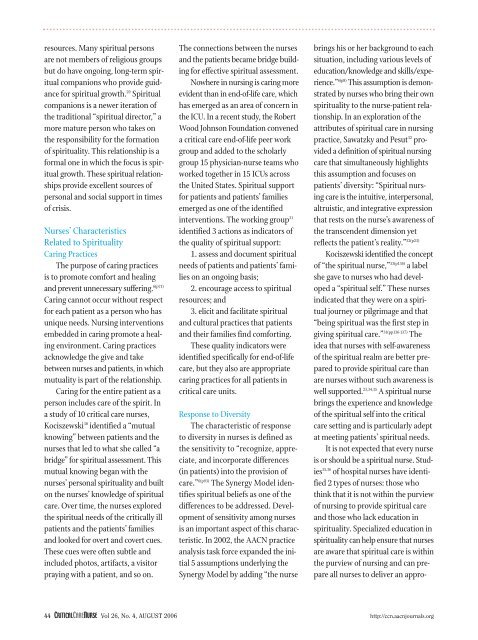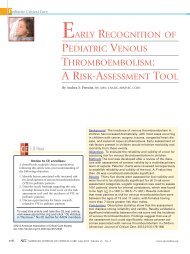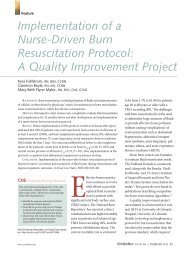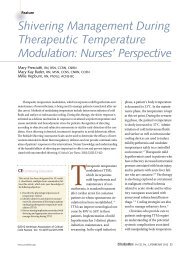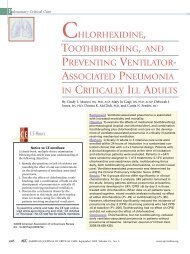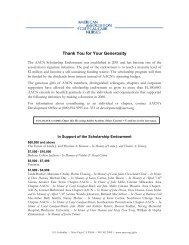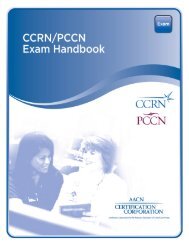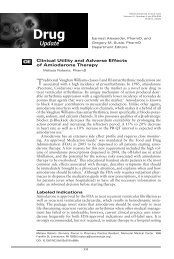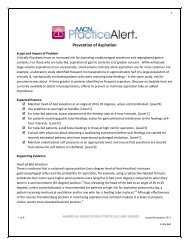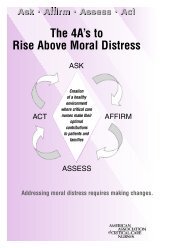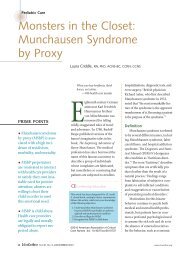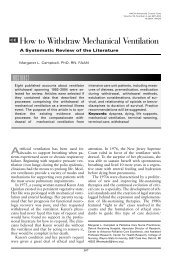Using the Synergy Model to Provide Spiritual Nursing Care in ...
Using the Synergy Model to Provide Spiritual Nursing Care in ...
Using the Synergy Model to Provide Spiritual Nursing Care in ...
Create successful ePaper yourself
Turn your PDF publications into a flip-book with our unique Google optimized e-Paper software.
esources. Many spiritual persons<br />
are not members of religious groups<br />
but do have ongo<strong>in</strong>g, long-term spiritual<br />
companions who provide guidance<br />
for spiritual growth. 29 <strong>Spiritual</strong><br />
companions is a newer iteration of<br />
<strong>the</strong> traditional “spiritual direc<strong>to</strong>r,” a<br />
more mature person who takes on<br />
<strong>the</strong> responsibility for <strong>the</strong> formation<br />
of spirituality. This relationship is a<br />
formal one <strong>in</strong> which <strong>the</strong> focus is spiritual<br />
growth. These spiritual relationships<br />
provide excellent sources of<br />
personal and social support <strong>in</strong> times<br />
of crisis.<br />
Nurses’ Characteristics<br />
Related <strong>to</strong> <strong>Spiritual</strong>ity<br />
Car<strong>in</strong>g Practices<br />
The purpose of car<strong>in</strong>g practices<br />
is <strong>to</strong> promote comfort and heal<strong>in</strong>g<br />
and prevent unnecessary suffer<strong>in</strong>g. 6(p71)<br />
Car<strong>in</strong>g cannot occur without respect<br />
for each patient as a person who has<br />
unique needs. <strong>Nurs<strong>in</strong>g</strong> <strong>in</strong>terventions<br />
embedded <strong>in</strong> car<strong>in</strong>g promote a heal<strong>in</strong>g<br />
environment. Car<strong>in</strong>g practices<br />
acknowledge <strong>the</strong> give and take<br />
between nurses and patients, <strong>in</strong> which<br />
mutuality is part of <strong>the</strong> relationship.<br />
Car<strong>in</strong>g for <strong>the</strong> entire patient as a<br />
person <strong>in</strong>cludes care of <strong>the</strong> spirit. In<br />
a study of 10 critical care nurses,<br />
Kociszewski 30 identified a “mutual<br />
know<strong>in</strong>g” between patients and <strong>the</strong><br />
nurses that led <strong>to</strong> what she called “a<br />
bridge” for spiritual assessment. This<br />
mutual know<strong>in</strong>g began with <strong>the</strong><br />
nurses’ personal spirituality and built<br />
on <strong>the</strong> nurses’ knowledge of spiritual<br />
care. Over time, <strong>the</strong> nurses explored<br />
<strong>the</strong> spiritual needs of <strong>the</strong> critically ill<br />
patients and <strong>the</strong> patients’ families<br />
and looked for overt and covert cues.<br />
These cues were often subtle and<br />
<strong>in</strong>cluded pho<strong>to</strong>s, artifacts, a visi<strong>to</strong>r<br />
pray<strong>in</strong>g with a patient, and so on.<br />
The connections between <strong>the</strong> nurses<br />
and <strong>the</strong> patients became bridge build<strong>in</strong>g<br />
for effective spiritual assessment.<br />
Nowhere <strong>in</strong> nurs<strong>in</strong>g is car<strong>in</strong>g more<br />
evident than <strong>in</strong> end-of-life care, which<br />
has emerged as an area of concern <strong>in</strong><br />
<strong>the</strong> ICU. In a recent study, <strong>the</strong> Robert<br />
Wood Johnson Foundation convened<br />
a critical care end-of-life peer work<br />
group and added <strong>to</strong> <strong>the</strong> scholarly<br />
group 15 physician-nurse teams who<br />
worked <strong>to</strong>ge<strong>the</strong>r <strong>in</strong> 15 ICUs across<br />
<strong>the</strong> United States. <strong>Spiritual</strong> support<br />
for patients and patients’ families<br />
emerged as one of <strong>the</strong> identified<br />
<strong>in</strong>terventions. The work<strong>in</strong>g group 31<br />
identified 3 actions as <strong>in</strong>dica<strong>to</strong>rs of<br />
<strong>the</strong> quality of spiritual support:<br />
1. assess and document spiritual<br />
needs of patients and patients’ families<br />
on an ongo<strong>in</strong>g basis;<br />
2. encourage access <strong>to</strong> spiritual<br />
resources; and<br />
3. elicit and facilitate spiritual<br />
and cultural practices that patients<br />
and <strong>the</strong>ir families f<strong>in</strong>d comfort<strong>in</strong>g.<br />
These quality <strong>in</strong>dica<strong>to</strong>rs were<br />
identified specifically for end-of-life<br />
care, but <strong>the</strong>y also are appropriate<br />
car<strong>in</strong>g practices for all patients <strong>in</strong><br />
critical care units.<br />
Response <strong>to</strong> Diversity<br />
The characteristic of response<br />
<strong>to</strong> diversity <strong>in</strong> nurses is def<strong>in</strong>ed as<br />
<strong>the</strong> sensitivity <strong>to</strong> “recognize, appreciate,<br />
and <strong>in</strong>corporate differences<br />
(<strong>in</strong> patients) <strong>in</strong><strong>to</strong> <strong>the</strong> provision of<br />
care.” 6(p93) The <strong>Synergy</strong> <strong>Model</strong> identifies<br />
spiritual beliefs as one of <strong>the</strong><br />
differences <strong>to</strong> be addressed. Development<br />
of sensitivity among nurses<br />
is an important aspect of this characteristic.<br />
In 2002, <strong>the</strong> AACN practice<br />
analysis task force expanded <strong>the</strong> <strong>in</strong>itial<br />
5 assumptions underly<strong>in</strong>g <strong>the</strong><br />
<strong>Synergy</strong> <strong>Model</strong> by add<strong>in</strong>g “<strong>the</strong> nurse<br />
br<strong>in</strong>gs his or her background <strong>to</strong> each<br />
situation, <strong>in</strong>clud<strong>in</strong>g various levels of<br />
education/knowledge and skills/experience.”<br />
6(p8) This assumption is demonstrated<br />
by nurses who br<strong>in</strong>g <strong>the</strong>ir own<br />
spirituality <strong>to</strong> <strong>the</strong> nurse-patient relationship.<br />
In an exploration of <strong>the</strong><br />
attributes of spiritual care <strong>in</strong> nurs<strong>in</strong>g<br />
practice, Sawatzky and Pesut 32 provided<br />
a def<strong>in</strong>ition of spiritual nurs<strong>in</strong>g<br />
care that simultaneously highlights<br />
this assumption and focuses on<br />
patients’ diversity: “<strong>Spiritual</strong> nurs<strong>in</strong>g<br />
care is <strong>the</strong> <strong>in</strong>tuitive, <strong>in</strong>terpersonal,<br />
altruistic, and <strong>in</strong>tegrative expression<br />
that rests on <strong>the</strong> nurse’s awareness of<br />
<strong>the</strong> transcendent dimension yet<br />
reflects <strong>the</strong> patient’s reality.” 32(p23)<br />
Kociszewski identified <strong>the</strong> concept<br />
of “<strong>the</strong> spiritual nurse,” 33(p136) a label<br />
she gave <strong>to</strong> nurses who had developed<br />
a “spiritual self.” These nurses<br />
<strong>in</strong>dicated that <strong>the</strong>y were on a spiritual<br />
journey or pilgrimage and that<br />
“be<strong>in</strong>g spiritual was <strong>the</strong> first step <strong>in</strong><br />
giv<strong>in</strong>g spiritual care.” 31(pp136-137) The<br />
idea that nurses with self-awareness<br />
of <strong>the</strong> spiritual realm are better prepared<br />
<strong>to</strong> provide spiritual care than<br />
are nurses without such awareness is<br />
well supported. 23,34,35 A spiritual nurse<br />
br<strong>in</strong>gs <strong>the</strong> experience and knowledge<br />
of <strong>the</strong> spiritual self <strong>in</strong><strong>to</strong> <strong>the</strong> critical<br />
care sett<strong>in</strong>g and is particularly adept<br />
at meet<strong>in</strong>g patients’ spiritual needs.<br />
It is not expected that every nurse<br />
is or should be a spiritual nurse. Studies<br />
35,36 of hospital nurses have identified<br />
2 types of nurses: those who<br />
th<strong>in</strong>k that it is not with<strong>in</strong> <strong>the</strong> purview<br />
of nurs<strong>in</strong>g <strong>to</strong> provide spiritual care<br />
and those who lack education <strong>in</strong><br />
spirituality. Specialized education <strong>in</strong><br />
spirituality can help ensure that nurses<br />
are aware that spiritual care is with<strong>in</strong><br />
<strong>the</strong> purview of nurs<strong>in</strong>g and can prepare<br />
all nurses <strong>to</strong> deliver an appro-<br />
44 CRITICALCARENURSE Vol 26, No. 4, AUGUST 2006 http://ccn.aacnjournals.org


